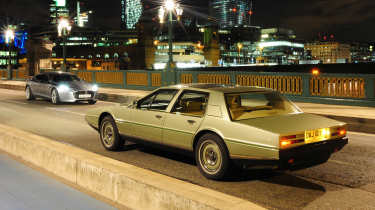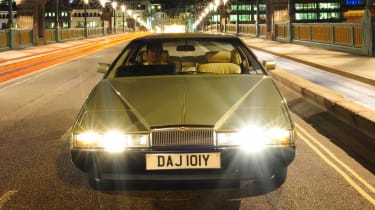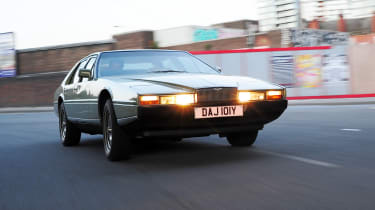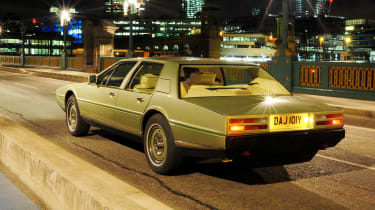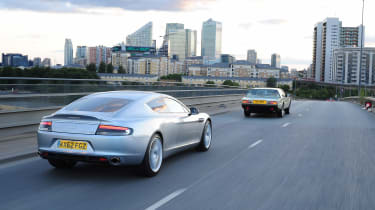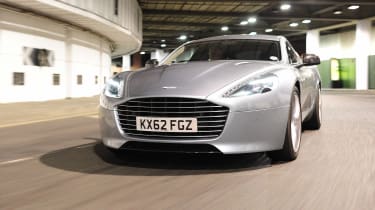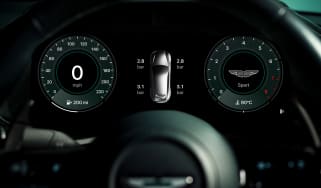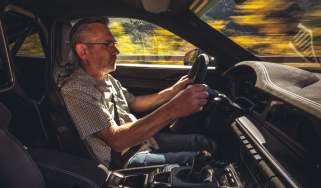Aston Martin Rapide S v Aston Martin Lagonda
We compare Aston’s four-door saloon, the Rapide S, with its 1970s predecessor, the weird and rather wonderful Lagonda
The year is 1976 and Aston Martin is on its uppers. Again. For a company that’s spent much of the previous 63 years turning insolvency into an art form, it’s nothing new, but it’s fair to say that straits have rarely been this dire.
The DBS is a typically potent and handsome machine, but in the wake of a global oil crisis that has seen a vicious spike in energy costs, petrol rationing and increasing political tensions between West and Middle East, thirsty GT cars are hardly flying out of the door. So what do you pin your hopes on to see you through such turbulent times? Why, an outlandish, fiercely expensive two-ton, V8-powered luxury saloon of course.
> £1.75m Aston Martin V12 Vantage Zagato Heritage Twins by R-Reforged revealed in the flesh
Hindsight suggests this decision was at best optimistic, at worst suicidal, especially as deliveries didn’t commence for a further three years, by which time the world was in the grip of another oil crisis. As always with these things, timing is everything. Factor-in legendary unreliability, single-digit fuel consumption, an obsession with increasingly ambitious and hopelessly dysfunctional instrumentation and truly extraordinary William Towns styling and you have what appears to be the perfect storm of harebrained 1970s lunacy and Aston Martin’s uncanny knack of powering full-throttle from the frying pan into the fire.
Yet, remarkably, history tells a different tale. One of initial resistance, but eventual redemption, with no fewer than 645 Lagonda ‘wedges’ produced between 1979 and 1990. It’s no great exaggeration to suggest it was the unlikely saviour of the company. Perhaps more miraculous is the fact that the Lagonda’s ability to court controversy and slacken jaws remains undiminished, at least to this car-obsessed child of the ’70s.
All of which leads us to the door of Studio 434, an incredible private collection of more than 175 cars and motorcycles located near Potters Bar on the outskirts of London. A veritable treasure trove, stuffed to the gunwhales with all manner of machines from the exotic to the obscure, it features what must be the largest collection of Towns Lagondas anywhere in the world. Quite how you end up with 14 of them, only father and son Rodger and Guy Dudding know. But I’m glad of their obsession because it means we can take our pick from a razor-edged Series 2 (the 1982 British Motor Show car, no less) through numerous Series 3s to the very last Series 4 built. Unsuprisingly I’m drawn to the S2, complete with its fabulous ‘folded paper’ styling, original LED instruments and monospoke steering wheel.
The trouble with bold attempts at futurism is they tend to look comedically old-fashioned in the blink of an eye. The Lagonda is different. Nowadays we’ve grown used to the future feeling as though it’s one small step away from the present. Back in the ’70s, when supersonic air travel and manned space exploration were the norm, forward thinking required giant leaps to make an impact. Almost four decades after it was launched, time is still trying to catch up with William Towns’s vision of the future.
There are many amazing things about the Lagonda. The shock value of its sheer size, straight edges and extended front and rear overhangs never wanes, but when you spend time with it your eye gets beyond the audacity and finds genuine beauty in the stance and purity of line. Of course it’s also the original ‘Marmite’ car, dismissed as a joke or maligned with ‘Ugliest Car in the World’ epithets, but judging by the many, many people who approach us during our time with the car, it also has plenty of fans.
So dominant is the styling that it threatens to render the driving experience almost inconsequential. To be honest I had worried it would be totally underwhelming, or worse, utterly hopeless. I’m pleased to say such fears prove unfounded within the first few miles. But I’ll qualify that by saying that enjoying the Lagonda relies totally on keeping an open mind. Approach it as you would a modern machine – indeed the Rapide S we’ve brought along to keep it company – and you’ll never get your head around it. As its styling suggests, the Lagonda is something completely different.
This is a luxury car in the ’70s shag-pile sense of the word, with little pretence at genuine sporting prowess. You sit low within it, sunk deep into the exceptionally comfortable seat, hands resting on the surprisingly small, bizarre-looking steering wheel and peering at the huge black void of a dashboard. Ah yes, the instruments. In this S2 model all the car’s vital signs are displayed via a myriad red LED digital panels. There’s no logic to the positioning of these, so your speed is top left. Directly beneath it is the tacho, which gives you a two-digit figure for engine revs. Fuel is shown as a percentage figure in the right-hand side of the display. It’s all very Texas Instruments (if you’re younger than 30 you’d best Google it), strangely hypnotic, terribly confusing and totally illegible in bright sunlight. The switchgear is like something from a classic Bang & Olufsen hi-fi. In short, it’s magnificent. And magnificently bonkers.
Powered by Aston’s famed 5.3-litre V8 (fed by a quartet of Weber carburettors) the Lagonda has a quoted 280bhp and 360lb ft of torque to propel its two-ton mass, via a three-speed GM TorqueFlite automatic transmission. Wheels are modest (by modern standards) 15in x 7in, wearing generously sidewalled Avon tyres. After churning on the ignition key for just long enough to have you worried, the V8 fires into life, each prod of the accelerator shimmying the Lagonda on its soft coil springs. Pull the sliding gear selector into ‘D’, ease your foot from the brake to the accelerator and the big wedge rumbles away. An involuntary smile spreads across your face.
As road test results from the day suggest (0-60mph in 8sec, 0-100mph in around 20), from a standstill you don’t so much accelerate as gain momentum, but once up to cruising speed it feels truly majestic. On the trip down to London’s Docklands for our nocturnal photoshoot, the Lagonda makes imperious progress, mixing it with modern traffic and continually causing near-accidents as other drivers fumble for camera-phones and circle with mouths agape. Inside, all is serene. It’s an over-used phrase, but this truly is a car in which you could drive across a continent and still feel fresh at your destination.
The Lagonda’s appetite for corners is less ravenous, the soft suspension yielding all-too-soon to the surprisingly quick-witted steering. The Avons squeal their disapproval when you point the long nose enthusiastically into a turn, but beneath the nautical levels of roll the Lagonda handles tidily, with a sweet balance of grip front-to-rear and impressive agility for a car so dedicated to comfort. It’s not a luxury sports car in the current sense (as we’ll discover in a moment), but it’s more feelsome and enjoyable to drive – as opposed to waft – than you’d credit.
Another observation worth noting is it is very definitely a passenger’s car as well as a driver’s car. Comfort levels are right up there with your sofa after Sunday lunch, and the interior itself is simple yet supremely stylish. In the rear there’s more room than you’d expect considering the car’s knee-high stance, and the glass panel in the rear section of the roof really does enhance your feeling of space. Then again, as the rear windows are fixed (they simply don’t have anywhere to drop into thanks to the way the rear doors cut around the wheelarches) you need something to suppress any feelings of claustrophobia.
Aston Martin Lagonda
| Engine | V8, 5340cc |
| Max power | 280bhp @ 5000rpm |
| Max torque | 360lb ft @ 3000rpm |
| Transmission | Three-speed automatic, rear-wheel drive |
| Steering | Rack-and-pinion, power-assisted |
| Brakes | Vented discs front and rear |
| Wheels | 7 x 15in front and rear |
| Tyres | 235/70 R15 front and rear, Avon Turbosteel |
| Weight | 2064kg |
| Power to weight | 138bhp/ton |
| 0-60mph | 7.9sec (claimed) |
| Top speed | 148mph (claimed) |
| Price new | £50,000 in 1980 (£182,000 in today’s money) |
| Value now | from c£20,000 |
Fast-forward to 2013 and Aston Martin is in comparatively good shape. Times have been tough recently, but they came on the back of a period of unprecedented success, thanks to a new headquarters at Gaydon and a range of cars based upon clever cleansheet design and engineering. With fresh investment and the ink still wet on an engine and technology deal with Mercedes AMG, the future is complicated and filled with legislative, economic and environmental challenges, but it’s a world away from the dark days the Lagonda was born into.
To see the Rapide S in close company with the Towns Lagonda is to see how far Aston Martin has come. Now referred to as a brand rather than a car company, Aston is supremely cool, but in the manicured, carefully managed 21st-century sense, not the maverick and slightly bonkers style of the ’70s. Nevertheless, when Dr Bez first started talking about a four-door Aston Martin it’s fair to say eyebrows were raised, perhaps because what came before was notorious for all the wrong reasons.
> Aston Martin DBS Superleggera review – a mighty V12 GT with supercar speed
When launched, the original Rapide was lauded for its beauty, quality and dynamism, but criticised for its derivative looks, awkward rear access and a fundamental lack of rear occupant space compared with rivals such as the Porsche Panamera. The Rapide S is the first major evolution of that original car, and while there’s no question that the more aggressive grille and headlight treatment has given it a stronger identity and the new 550bhp ‘Gen4’ quad-cam V12 engine has sharpened its performance still further, when it comes to rear-seat space and comfort, the Lagonda has it licked.
The Lagonda may render it effectively invisible to bystanders, but in isolation the Rapide S has film-star charisma. It has a tremendous sense of scale and presence, and without wishing to sound all designery, the way the light flows along its flawless flanks is truly breathtaking. The fact it has four doors (five if you count the usefully practical hatchback) only adds to the drama, if only because your eye struggles to reconcile how such a big car can look so lithe.
The driving environment holds no surprises, but like the exterior the interior benefits from a painstaking approach. I suspect Towns would enjoy the theatre of the gracefully rising tweeters of the Bang & Olufsen hi-fi, but I suspect he’d have installed a vast bank of iPhone-style Retina display touchscreens where the analogue dials reside.
It may have four seats, but the Rapide S is very definitely a sports car first, luxury car second. Adaptive damping gives you increasingly firm settings, a Sport mode sharpens the throttle response, cuts the gearshift times of the six-speed paddle-shift automatic and opens the throats of the twin exhausts to emit a deliciously raucous bellow.
From the moment you turn the steering wheel or caress the throttle, the Rapide S seduces you with its abundant urge and smoothly measured control. The steering is weighty and connected, the engine hugely muscular, the ride firm but rounded in a way many 190mph cars fail to manage. When you have the opportunity, it really does fire you down the road like a true sports car, with grip levels, traction and braking that are so far in advance of anything the Lagonda can summon as to make any dynamic comparison seem laughable.
It also loves long distances, but the delivery isn’t as laidback as the positively louche Lagonda; instead the Rapide S prefers to champ at the bit a little in the hope you’ll take the twisty way to your destination. Whatever the journey, there’s no question it’s a beguiling car and one that’s an event to drive or be driven in.
Though we’d never had any experience of the Lagonda prior to this test it’s fair to say we knew it would be the star. What we perhaps didn’t expect was to find it such an appealing, accomplished car. Every journey simply melted beneath its wheels, and the sense of occasion never waned. Nor, it has to be said, did the slight sense of dread that accompanied every effort to start it, though in fact it proved us all wrong by never missing a beat. Even the dashboard worked, which has to be some kind of miracle.
It might have been the butt of jokes for the best part of four decades, but, based upon our time with it, if you still regard the Lagonda as something to laugh at, then, my friend, the joke is on you.
Aston Martin Rapide S
| Engine | V12, 5935cc |
| Max power | 550bhp @ 6750rpm |
| Max torque | 457lb ft @ 5500rpm |
| Transmission | Six-speed automatic, transaxle, rear-wheel drive, limited-slip differential, ESP |
| Steering | Rack-and-pinion, power-assisted |
| Brakes | Vented discs, 398mm front, 360mm rear, ABS |
| Wheels | 8.5 x 20in front, 11 x 20in rear |
| Tyres | 245/40 ZR20 front, 295/35 ZR20 rear, Bridgestone S0001 |
| Weight | 1990kg |
| Power to weight | 281bhp/ton |
| 0-60mph | 4.8sec (claimed) |
| Top speed | 190mph |
| Price new | £149,995 |
| Value now | from £50,000 |
This story first appeared in issue 003 of 'Vantage', our quarterly sister magazine based on all things Aston Martin. Subscribe to Vantage magazine here.
